Sony
Bravia
8:
Two-minute
review
Sony
consolidated
its
TV
lineup
for
2024
with
fewer
models
and
a
naming
convention
that
was
easier
to
follow.
Perhaps
what
was
most
interesting
about
this
move
was
that
a
mini-LED
TV
–
the
Bravia
9
–
was
spearheading
the
charge
as
the
new
flagship
Sony
TV,
effectively
demoting
OLED
to
the
next
rung
down.
Enter
the
Bravia
8,
a
pure
WOLED
screen
that
replaces
the
excellent
A80L.
If
you
want
the
absolute
pinnacle
of
Sony’s
OLED
prowess,
the
A95L
released
in
2023
is
still
available
to
buy,
complete
with
its
much
higher
price
tag.
But
you
may
not
feel
the
need
to
stretch
that
high,
since
the
Bravia
8
(on
review
here)
takes
the
A80L’s
winning
formula
and
makes
a
few
notable
improvements.
Sony
claims
this
latest
mid-range
OLED
model
is
brighter
than
its
predecessor,
yet
manages
to
do
without
some
of
the
brightness-boosting
tech
we’ve
seen
applied
to
other
OLED
TVs
in
the
past
couple
of
years.
Instead,
the
Bravia
8
relies
on
Sony’s
new
Bravia
XR
processor
to
do
the
proverbial
heavy
lifting
and
stake
a
claim
as
one
of
the
best
OLED
TVs
you
can
buy.
This
processor
harnesses
the
power
of
AI
to
better
understand
the
image
on
screen
and
make
adjustments
to
ensure
it’s
delivered
at
its
absolute
best.
And
it
does
(for
the
most
part)
improve
over
the
A80L
where
brightness
is
concerned
to
deliver
a
gorgeous
picture
no
matter
if
you’re
watching
TV
or
movies,
or
playing
games.
Sony’s
Acoustic
Surface+
audio
system
makes
a
return,
maintaining
the
brand’s
position
as
being
one
of
the
best
TVs
for
sound
thanks
to
actuators
placed
behind
the
screen
to
physically
vibrate
it
–
a
feature
that’s
exclusive
to
Sony
TVs.
It
means
the
Bravia
8
can
go
loud,
is
dynamically
impressive
and
is
capable
of
placing
objects
within
a
soundfield
better
than
many
other
flat-screen
TVs.
When
connected
to
one
of
Sony’s
latest
Bravia
Theater
soundbars
–
the
Theater
Bar
8
is
a
natural
pairing
–
an
Acoustic
Center
Sync
feature
can
be
used
to
turn
the
TV
into
a
dedicated
center
channel
speaker.
The
Bravia
8
is
a
great
option
for
gamers
thanks
to
its
support
of
all
the
major
gaming
features,
including
4K
support
at
120Hz,
an
auto
low-latency
mode
(ALLM),
variable
refresh
rate
(VRR)
and
Sony’s
‘Perfect
for
PS5’
tech
that
automatically
adjusts
picture
settings
to
their
optimum
–
for
both
games
and
movies
–
when
a
PlayStation
5
console
is
detected
in
either
of
its
two
HDMI
2.1
inputs.
Yep,
the
Bravia
8
still
only
supports
4K/120Hz
across
two
of
its
four
HDMI
inputs
and
you’ll
need
to
use
the
one
marked
‘eARC’
if
you
plan
to
connect
an
external
soundbar.
Sony
isn’t
alone
in
offering
support
across
only
half
of
its
TV’s
inputs,
but
it’s
a
shame
that
it’s
still
happening
in
2024.
The
main
caveat
at
the
time
of
writing,
however,
is
that
in
some
territories
the
A80L
is
still
readily
available
and
for
a
more
affordable
price.
While
there’s
no
doubt
the
Bravia
8
makes
improvements
over
its
predecessor,
some
customers
either
won’t
notice,
or
won’t
care
for
the
admittedly
incremental
upgrades.
The
Bravia
8
is
indeed
Sony’s
best
mid-range
OLED,
but
it’s
not
quite
the
generational
leap
we’ve
seen
between
some
other
TV
series
–
see
the
improvements
Samsung
makes
each
year
with
its
S95
QD-OLED
series
as
an
example.
Sony
Bravia
8
review:
Price
and
release
date
-
Announced
in
April
2024
for
July
2024
launch -
Pricing
starts
at
$2,799
/
£2,699
/
AU$3,495
(55-inch) -
No
83-inch
model
in
2024
The
Sony
Bravia
8
was
announced
in
April
2024
and
released
in
July
2024
in
55-,
65-
and
77-inch
sizes.
The
A80L
predecessor
was
available
in
a
larger
83-inch
size,
but
that
has
seemingly
been
dropped
this
time
around.
Pricing
has
remained
relatively
consistent
compared
to
the
A80L,
with
the
65-inch
model
I’ve
reviewed
setting
you
back
$2,799
/
£2,699
/
AU$4,495.
That’s
$200
/
£200
more
expensive
than
the
A80L
in
the
US
and
UK
and
the
same
as
the
A80L’s
launch
price
in
Australia.
Since
launch,
we’ve
already
seen
small
price
drops
in
all
markets,
so
it’s
unlikely
you
would
need
to
pay
the
full
suggested
retail
price
if
you
decide
to
buy.
The
55-inch
Bravia
8
has
been
priced
at
$2,799
/
£2,699
/
AU$3,495
while
the
range-topping
77-inch
retails
for
$3,899
/
£3,499
/
AU$6,995.
The
Sony
Bravia
8’s
pricing
once
again
puts
it
squarely
up
against
the
LG
C4
(the
A80L
and
LG
C3
were
similarly
priced
in
2023)
and
in
most
cases,
LG’s
mid-range
OLED
comes
out
the
more
affordable,
and
it’s
available
in
a
greater
variety
of
sizes.
LG’s
telly
offers
full
4K/120Hz
support
across
all
four
HDMI
inputs,
making
it
a
better
prospect
for
gamers
and
those
with
multiple
external
devices,
but
as
was
the
case
in
2023,
LG’s
TV
has
weaker
built-in
sound.
Sony
Bravia
8
review:
Specs
to
scroll
horizontally
|
Screen type: | OLED |
|
Refresh rate: | 120Hz |
|
HDR support: |
HDR10, HLG, Dolby Vision |
|
Audio support: |
Dolby Atmos, DTS |
|
Smart TV: |
Google TV |
|
HDMI ports: |
4 (2x HDMI 2.1) |
Sony
Bravia
8
review:
Benchmark
results
Sony
Bravia
8
review:
Features
-
New
Bravia
XR
processor -
Voice
Zoom
3
for
improved
vocal
clarity -
New
eco-friendly
remote
control
The
Sony
Bravia
8
uses
a
standard
WOLED
panel
as
found
in
its
A80L
predecessor,
but
the
key
metric
Sony
is
keen
to
advertise
with
the
Bravia
8
is
that
it’s
capable
of
going
10%
brighter,
thanks
to
the
aforementioned
XR
Processor.
There’s
no
Micro
Lens
Array
(MLA)
or
QD-OLED
tech
to
be
found
here,
so
it
is
strictly
the
power
of
the
new
chip
and
its
ability
to
better
understand
how
to
manipulate
lighting
that
is
going
to
result
in
that
brightness
boost.
Indeed,
Sony
says
its
new
XR
chip
can
better
detect
objects
in
scenes
with
greater
accuracy
and
will
then
automatically
optimize
the
picture
to
get
as
close
to
the
creator’s
intentions
as
possible.
Also
new
in
the
Bravia
8
is
a
dedicated
Prime
Video
Calibrated
Mode
(also
a
feature
of
the
flagship
Bravia
9)
which
will
automatically
adjust
picture
settings
when
you’re
watching
a
raft
of
content
on
Amazon’s
streaming
service.
This
is
in
addition
to
the
Netflix
Calibrated
Mode
and
Sony
Pictures
Core
Calibrated
Mode,
both
of
which
work
in
similar
ways
and
have
been
carried
over
from
the
outgoing
A80L.
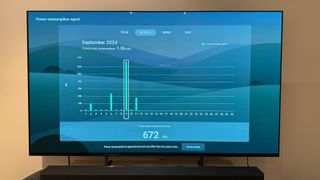
The
latest
iteration
of
Sony’s
Eco
Dashboard
gives
clear
insights
into
how
much
energy
the
TV
is
using.
(Image
credit:
Future
/
Max
Langridge)
Voice
Zoom
3,
also
taken
from
the
high-end
Bravia
9,
is
integrated
into
the
Bravia
8,
which
can
be
used
to
boost
(or
decrease)
voices
and
dialogue
in
whatever
content
you’re
watching.
Elsewhere,
there
is
little
to
separate
the
Bravia
8
and
A80L
from
a
features
perspective.
Both
support
Dolby
Vision,
HDR10
and
HLG
HDR
formats
(no
HDR10+)
and
the
Bravia
8
once
again
gets
Google
TV
as
the
operating
system
of
choice.
Sony’s
second
iteration
of
its
Eco
Dashboard
makes
an
appearance
too,
allowing
you
to
adjust
various
energy-saving
features
and
view
their
effects
in
a
neat
bar
graph-style
chart.
Sony
also
ships
the
Bravia
8
with
a
new
Eco
Remote
that
has
a
slight
speckled
appearance.
This
remote
is
made
from
80%
recycled
materials,
is
backlit
and
recharges
via
USB-C.
-
Features
score:
4.5
/
5
Sony
Bravia
8
review:
Picture
quality
-
Wonderfully
natural
colors -
Slightly
increased
brightness
for
improved
HDR
performance -
Performs
at
its
best
in
darker
rooms
Sony’s
claims
of
the
Bravia
8
benefitting
from
a
10%
brightness
increase
over
the
A80L
certainly
carry
some
weight,
with
its
latest
OLED
TV
recording
a
149.5
nits
measurement
in
HDR
Filmmaker
Mode
on
a
full
screen,
compared
to
the
A80L’s
139
nits
based
on
our
measurements.
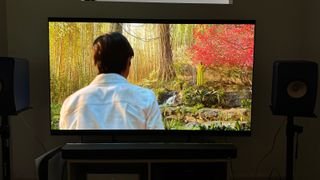
(Image
credit:
Future
/
Max
Langridge)
There
are
noticeable
differences
in
the
10%
window
brightness
measurements
in
both
HDR
and
SDR
Standard
modes,
too.
HDR
Standard
returned
a
result
of
816.7
nits
on
the
Bravia
8
(compared
to
the
A80L’s
741
nits),
while
SDR
Standard
saw
the
Bravia
8
improve
upon
the
A80L’s
247
nits
with
a
measurement
of
287.9
nits.
Interestingly,
measurements
taken
for
SDR
content
in
Filmmaker
mode
(or
rather,
Sony’s
own
version
called
Professional)
returned
vastly
different
results
and
not
in
the
Bravia
8’s
favor,
with
a
measurement
of
99.4
nits
compared
to
the
A80L’s
224,
indicating
this
is
a
picture
mode
you’ll
want
to
avoid
when
watching
SDR
content.
Outside
of
this,
it
should
mean
the
Bravia
8
will
take
everything
that
we
loved
about
the
A80L
but
throws
in
a
helping
of
improved
contrast
and,
with
the
new
XR
Processor
acting
as
the
brains
of
the
operation,
finer
control
of
light
for
improved
HDR
performance.
As
for
color
performance,
the
Bravia
8
does
well
against
some
of
its
closest
competitors,
covering
99.1%
of
the
UHDA-P3
color
gamut
and
75%
BT.2020.
The
LG
C4,
by
comparison,
returned
results
of
98.7%
and
72.7%,
respectively.
For
my
real-world
performance
tests,
I
streamed
the
opening
fight
sequence
between
Ta
Lo
and
Xu
Wenwu
in
Shang-Chi
and
the
Legend
of
the
Ten
Rings
on
Disney
Plus
in
its
IMAX
Enhanced
version.
It’s
a
glorious
test
of
color
with
various
shades
of
green,
yellow
and
red
as
the
two
go
head-to-head
with
their
own
fighting
styles.
I
was
watching
in
a
dark
room
and
so
selected
the
Dolby
Vision
Bright
picture
setting,
which
increases
brightness
without
any
sacrifice
to
detail
and
found
the
Bravia
8
reproduced
this
scene
beautifully.
Dolby
Vision
Dark
was
a
little
too
dim
for
my
preference
in
this
case.
Sony’s
XR
Triluminos
Pro
technology,
which
aims
to
reproduce
natural
and
accurate
colors,
worked
to
full
effect,
with
the
greens
and
yellows
of
the
forest
setting
looking
incredibly
realistic
–
it
was
easy
to
notice
the
different
shades
depending
on
where
the
light
was
hitting
and
the
characters’
faces
were
clear
and
detailed.
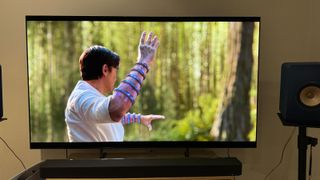
The
Sony
Bravia
8
demonstrates
excellent
control
of
light
and
highlights
(Image
credit:
Future
/
Max
Langridge)
Even
the
rings
around
Xu
Wenwu’s
arms
gave
off
a
satisfying
blue
shine
as
they
were
powering
up
for
attack,
highlighting
the
Bravia
8’s
–
and
more
specifically,
the
XR
Contrast
Booster’s
–
ability
to
precisely
control
the
light.
What
makes
this
all
the
more
impressive
is
the
fact
that
there
is
no
MLA
technology
or
Quantum
Dot
layer,
but
instead
a
traditional
WOLED
panel.
After
we
meet
present-day
Shang
Chi
and
he’s
speaking
with
friends
in
a
dimly
lit
bar,
the
Sony
Bravia
8
flexes
its
muscles
with
regard
to
picking
out
detail
where
there’s
little
to
no
light.
His
dark
T-shirt
is
clearly
distinguishable
from
his
even
darker
cardigan,
while
the
stripes
on
his
female
friend’s
blazer
can
also
be
seen.
There’s
no
discernible
light
blooming
around
the
bright
table
lamps,
both
the
one
at
the
front
and
center
of
the
screen,
and
the
numerous
others
dotted
about
in
the
background.
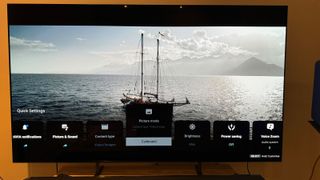
The
Sony
Bravia
8
offers
the
option
to
switch
to
a
dedicated
‘calibrated’
mode
when
watching
content
on
Prime
Video
(as
above),
Netflix
or
Sony
Pictures
Core
(Image
credit:
Future
/
Max
Langridge)
An
Ultra
HD
stream
of
The
Ministry
of
Ungentlemanly
Warfare
on
Prime
Video
provided
a
good
opportunity
to
test
out
the
new
Prime
Video
Calibrated
Mode.
Switching
this
mode
on
and
off
is
as
simple
as
toggling
a
switch
in
the
picture
settings,
but
in
the
instance
for
this
particular
movie,
I
noticed
absolutely
no
difference
between
the
Calibrated
picture
settings
and
Sony’s
own
Professional
picture
mode
(the
brand’s
version
of
Filmmaker
mode).
This
could
potentially
be
because
the
Bravia
8
doesn’t
support
HDR10+,
which
Prime
Video
uses,
but
regardless,
in
either
mode,
I
was
presented
with
a
beautiful,
natural
image
with
great
depth.
I
compared
the
same
opening
scene
on
the
LG
G4
and,
while
the
better-specced
TV
did
have
more
refined
light
control,
it
wasn’t
quite
the
stark
difference
I
was
initially
expecting
–
which
is
kudos
to
Sony.
I
switched
the
overhead
lights
on
and
loaded
up
Kingdom
of
the
Planet
of
the
Apes
on
Disney
Plus
–
while
there
was
a
fair
amount
of
reflection
noticeable
in
the
opening,
very
dark
scene,
it
wasn’t
enough
to
distract
me
from
my
viewing.
And
that
viewing
was
glorious,
with
the
Bravia
8
managing
to
pick
out
the
individual
strands
of
fur
on
the
apes,
while
also
handling
Caesar’s
burning
funeral
pyre
without
any
noticeable
signs
of
blooming.
-
Picture
quality
score:
4.5
/
5
Sony
Bravia
8
review:
Sound
quality
-
Accurate
placement
of
object
sounds -
Dynamically
impressive -
Still
lacking
in
the
bass
department
Sony
has
once
again
employed
its
Acoustic
Surface
Audio+
technology
here,
which
sees
actuators
placed
behind
the
screen
to
physically
vibrate
it,
turning
the
entire
surface
into
a
speaker.
Not
a
lot
has
changed
in
this
iteration
compared
to
the
A80L,
although
Sony
says
its
added
a
new
tweeter
to
help
boost
higher
frequencies
and,
in
particular,
dialogue.
It’s
a
really
remarkable
system
–
and
the
first
time
I’ve
personally
heard
it
in
action
–
as
when
using
the
same
opening
fight
sequence
from
Shang
Chi,
gusts
of
wind,
flailing
arms
and
attacks
using
the
10
rings
were
accurately
placed
within
the
soundfield;
when
an
attack
was
landed
towards
the
bottom
left
of
the
screen
for
example,
that’s
exactly
where
it
could
be
heard,
as
opposed
to
a
full
sound
coming
from
all
speakers.
When
I
began
the
stream,
I
received
a
pop-up
asking
if
I
wanted
to
activate
the
IMAX
Enhanced
DTS:X
soundtrack
(the
Sony
Bravia
8
is
an
IMAX
Enhanced-certified
TV)
and
there
was
a
genuine
effect
of
height
to
the
audio.
These
effects
were
only
amplified
the
louder
I
turned
up
the
volume
and
they
remained
distortion-free.
The
Voice
Zoom
3
feature
works
incredibly
well,
too,
for
any
spoken
content
that
you
may
have
a
little
trouble
hearing.
Not
only
does
increasing
the
level
help
dialogue
become
easier
to
hear,
it
does
so
without
sounding
separate
from
the
rest
of
the
soundtrack
or
other
audio,
instead
sounding
entirely
natural.
The
same
feature
can
be
used
when
connected
to
an
external
soundbar
or
speaker
system.
The
only
slight
downside
is
that
bass
performance
still
isn’t
a
strong
point
of
Sony’s
audio
system.
While
this
will
undoubtedly
be
a
blessing
to
your
neighbors,
it
does
mean
that
despite
the
Bravia
8
being
more
impressive
than
its
peers
in
the
sound
department,
you
will
want
to
invest
in
one
of
the
best
soundbars
to
experience
more
engaging
home
cinema
thrills.
Taking
the
car
chase
scene
from
The
Batman
as
a
prime
example,
there
isn’t
a
deep
rumble
from
the
Batmobile’s
engine
that
you
would
get
from
an
external
subwoofer,
but
is
certainly
more
engaging
than
most
other
TV
sound
systems.
-
Sound
quality
score:
4.5
/
5
Sony
Bravia
8
review:
Design
-
Height
adjustable
feet
in
two
positions -
Slimmer
rear
makes
it
easier
to
wall
mount -
Invisible
speakers
As
well
as
the
Bravia
8
delivering
a
10%
increase
in
brightness,
I’m
going
to
also
say
it’s
10%
better
looking.
For
starters,
Sony
has
slimmed
the
TV
down
to
a
depth
of
just
37mm,
making
it
easier
to
wall
mount
in
the
process.
This
is
due
to
Sony
removing
the
protruding
rear
housing
for
all
the
connections,
subwoofers
and
processing
electronics
on
the
A80L.
Instead,
the
rear
is
a
uniform
panel
–
something
Sony
calls
“One
Slate”
design
–
and
the
grid
of
etched
squares
has
now
been
increased
in
size
to
cover
the
entire
rear.
You’ll
still
find
a
similar
set
of
connections
on
the
right-hand
side
when
viewed
from
the
back,
including
four
HDMI
ports
(only
two
of
which
are
HDMI
2.1,
and
one
of
these
supporting
eARC),
optical
digital
audio
out,
an
ethernet
port,
RF
antenna
port,
two
USB
type-A
and
an
input
S-Center
speaker
input,
which
you
can
use
to
turn
the
TV
into
a
center
speaker
as
part
of
a
wider
external
sound
system.
If
you
connect
one
of
Sony’s
new
Bravia
Theater
soundbars,
you
can
bypass
the
need
for
this
connection
and
still
use
the
TV
as
a
center-channel
speaker
via
Acoustic
Center
Sync.
Also
new
for
the
Bravia
8
–
and
the
entire
2024
Bravia
lineup
–
is
the
ability
to
position
the
included
feet
in
any
of
four
ways,
up
from
the
previous
three.
You
can
position
them
in
either
a
narrow
or
wide
configuration
–
meaning
those
with
smaller
TV
stands
can
place
the
Bravia
8
on
top
with
little
issue
–
and
this
time
you
can
raise
the
screen
a
few
inches
in
both
narrow
and
wide
configurations,
to
better
accommodate
a
soundbar
beneath.
A
single
remote
control
comes
in
the
box
this
time
around,
which
is
effectively
the
same
as
the
one
that
shipped
with
the
A80L.
It’s
relatively
long
and
thin,
with
a
central
mic
button
for
voice
recognition
–
I
figure
this
positioning
is
Sony’s
attempt
to
encourage
users
to
interact
with
the
Bravia
8
more
with
their
voice
–
and
direct
buttons
for
six
streaming
services
at
the
bottom.
What
is
perhaps
more
interesting
about
this
remote
control,
however,
is
the
fact
it’s
made
from
approximately
80%
recycled
plastic,
and
the
way
in
which
Sony
produces
the
speckled
design
means
that
each
one
is
ever
so
slightly
different.
It’s
backlit
and
rechargeable
via
USB-C.
-
Design
score:
4.5
/
5
Sony
Bravia
8
review:
Smart
TV
and
menus
-
Google
TV
smart
system -
Google
Assistant
baked
in
and
‘Works
With’
Alexa/Apple
HomeKit
support -
Eco
Dashboard
2
for
power
saving
tips
The
Bravia
8
continues
Sony’s
appreciation
for
the
Google
TV
platform,
which
is
a
smart
thing
to
do.
As
expected,
the
full
suite
of
major
video
and
music
streaming
apps
is
available,
along
with
(quite
literally)
tens
of
thousands
of
others.
The
home
screen,
which
Google
TV
calls
‘For
You’,
shows
you
content
you’re
currently
in
the
middle
of
watching
across
any
installed
apps,
followed
by
recommended
content
based
on
your
viewing
habits
and
Google
Search
history
across
other
devices
when
you’re
logged
into
the
same
account.
Google
Assistant
is
available
for
voice
commands
and
to
help
you
find
whatever
you
want
faster.
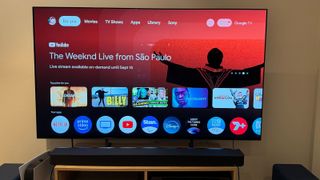
(Image
credit:
Future
/
Max
Langridge)
I
did
appreciate
Sony’s
implementation
of
a
quick
settings
menu
system,
whereby
you
just
press
a
button
on
the
remote
control
with
the
wrench
icon
to
bring
up
a
row
of
common
settings
along
the
bottom
of
the
screen,
each
with
its
own
set
of
choices
to
cycle
through.
The
order
of
these
can
be
personalized,
so
if
you
know
you’re
going
to
want
to
adjust
picture
and
sound
settings
the
most,
for
example,
you
can
place
these
at
the
start
of
the
row.
Sony
has
installed
the
second-generation
of
its
Eco
Dashboard
in
the
Bravia
8,
which
presents
the
TV’s
power
consumption
history
in
the
form
of
animated
graphs.
You
can
also
adjust
power-saving
settings
from
this
screen,
with
the
dashboard
indicating
how
much
power
in
kilowatt-hours
(kWh)
you’ll
save.
Naturally,
Chromecast
is
supported
for
streaming
to
the
TV
from
compatible
devices,
as
is
AirPlay
2.
And,
despite
using
Google
TV,
Sony
clearly
doesn’t
want
to
discriminate,
as
it’s
added
‘works
with’
support
for
Amazon
Alexa
and
Apple
HomeKit.
This
was
the
first
time
in
a
long
time
I’d
personally
used
Google
TV.
I’d
read
and
heard
good
things,
so
I
was
keen
to
experience
it
for
myself.
However,
in
comparison
to
LG’s
webOS
TV
system,
which
I’m
very
familiar
with,
I
found
Google
TV
here
to
be
quite
slow
and
clunky.
Button
presses
on
the
remote
control
weren’t
received
with
the
immediacy
I’d
expect
for
a
TV
of
this
caliber.
-
Smart
TV
and
menus
score:
3.5
/
5
Sony
Bravia
8
review:
Gaming
-
4K
@
120Hz
and
VRR
support -
Dolby
Vision
Gaming
for
compatible
sources -
Improved
12.8ms
input
lag
The
Bravia
8
presents
itself
as
a
great
option
for
gamers
thanks
to
its
excellent
color
reproduction
and
improved
HDR
brightness,
and
is
a
natural
partner
for
the
PlayStation
5
thanks
to
Sony’s
‘Perfect
for
PS5’
feature
that
automatically
adjusts
the
image
to
deliver
optimum
results.
Even
if
you
don’t
have
a
PS5,
you
can
still
benefit
from
VRR
and
ALLM,
while
Xbox
gamers
can
take
advantage
of
Dolby
Vision
Gaming.
During
my
testing,
I
measured
an
input
lag
of
12.8ms,
which
is
a
significant
improvement
over
the
16.5ms
lag
on
the
A80L,
putting
the
Bravia
8
on
par
with
the
likes
of
the
LG
G4,
although
the
LG
C4
–
Sony’s
closest
competitor
for
this
telly
–
undercuts
it
further
with
a
figure
of
9.2ms.
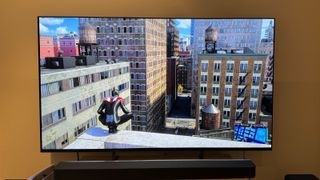
(Image
credit:
Future
/
Max
Langridge)
Loading
up
Marvel’s
Spider-Man
2
and
it’s
clear
the
Sony
Bravia
8’s
excellent
lighting
control
when
watching
video
content
is
carried
over
to
gaming.
Spidey’s
suit
and
buildings
exhibit
clear
shine
where
they’re
being
hit
by
sunlight,
while
the
stunning
vistas
in
Grand
Theft
Auto
5
exhibited
fantastic
depth,
with
plenty
of
detail
to
buildings
and
bushland
when
viewed
up
close.
Sony’s
Game
menu
pops
up
at
the
press
of
the
Menu
button
on
the
TV
remote
control,
bringing
up
quick-select
options
for
game
type,
toggling
VRR
on
or
off
and
a
new,
previously
promised
feature
to
adjust
the
screen
size.
You’re
also
able
to
toggle
on
an
on-screen
crosshair,
which
could
help
players
of
FPS
games
get
an
upper
hand.
The
picture
does
improve
when
switching
to
the
LG
G4,
but
this
is
to
be
expected
with
its
greater
control
of
light
and
increased
peak
brightness.
But,
for
a
mid-range
OLED,
the
Sony
Bravia
8
will
be
great
for
gamers.
The
only
thing
that
does
continue
to
hold
it
back
is
that
only
two
of
its
four
HDMI
ports
support
the
2.1
standard
for
4K/120Hz.
If
you
only
have
one
games
console,
this
won’t
be
an
issue
but,
if
you
have
multiple,
then
you’ll
be
better
served
by
a
model
from
LG
or
Samsung.
There’s
also
no
support
once
again
for
Nvidia
G-Sync
or
AMD
FreeSync.
-
Gaming
score:
4/5
Sony
Bravia
8
review:
Value
-
Small
premium
over
A80L
but
with
improved
performance -
Already
receiving
discounts -
LG
C4
can
be
found
for
similar
money
The
Sony
Bravia
8
presents
itself
as
good
value
for
money.
Its
launch
price
is
a
little
higher
than
its
predecessor
in
some
territories,
but
you
are
getting
a
number
of
upgrades,
such
as
the
new
processor
and
Dolby
Vision
Gaming
mode,
to
justify
it.
However,
since
launch,
we’ve
seen
its
price
come
down
and,
at
the
time
of
writing,
there
are
savings
of
up
to
$900
/
£200
/
AU$1,100
direct
from
Sony,
with
third-party
retailers
likely
price-matching
or
beating
those
prices.
While
some
may
have
wished
for
a
greater
leap
in
terms
of
brightness,
it’s
not
a
total
shock
that
Sony
has
continued
to
omit
brightness-boosting
technology,
such
as
MLA
or
Quantum
Dot,
as
these
technologies
are
reserved
for
the
flagship
screens
–
the
LG
C4
gets
the
same
treatment
for
example.
But
considering
what
the
Sony
Bravia
8
can
do,
such
as
displaying
movies
with
great
detail
and
light
control,
and
offering
up
a
number
of
picture
modes
that
work
well
as
opposed
to
the
one
or
two
you
sometimes
find
on
competitor
screens,
it’s
a
fantastic,
affordable
option
for
those
with
dark
rooms.
-
Value
score:
4/5
Should
I
buy
the
Sony
Bravia
8?
to
scroll
horizontally
| Attributes | Notes | Score |
|---|---|---|
| Features |
An upgraded processor and a suite of features for devoted movie fans | 4.5/5 |
|
Picture quality |
Natural colors and impressive clarity, but still not as bright as some flagship models | 4.5/5 |
|
Sound quality |
Excellent sound for a flat-screen TV, delivering great volume and effective positioning | 4.5/5 |
| Design |
Invisible speakers, four height positions and a wall-mount friendly depth | 4.5/5 |
|
Smart TV and menus |
Google TV is logical and intuitive to navigate, but occasional stuttering hinders a smooth experience | 3.5/5 |
| Gaming |
Improved 12.8ms input lag, 4K @ 120Hz and VRR support over two HDMIs | 4/5 |
| Value |
Well-priced considering performance, especially with discounts already dropping | 4/5 |
Buy
it
if…
Don’t
buy
it
if…
Also
consider…
to
scroll
horizontally
|
Header Cell – Column 0 |
Sony Bravia 8 |
LG C4 |
TCL C855 |
Hisense U8N |
|---|---|---|---|---|
|
Price (65-inch) |
$2,799 / £2,699 / AU$4,495 |
$2,699.99 / £2,699 / AU$4,299 |
£1,299 / AU$2,295 |
$1,499.99 / £1,799 / AU$2,699.99 |
|
Screen type | OLED | OLED |
QD mini-LED |
QLED with mini-LED |
|
Refresh rate | 120Hz | 120Hz | 144Hz | 144Hz |
|
HDR support |
Dolby Vision, HDR10, HLG |
Dolby Vision, HDR10, HLG |
Dolby Vision, HDR10+, HDR10, HLG |
Dolby Vision IQ, HDR10+, HDR10, HLG |
|
Smart TV |
Google TV |
webOS 24 |
Google TV |
Google TV (US), VIDAA elsewhere |
|
HDMI ports |
4x (2x HDMI 2.1) |
4x HDMI 2.1 |
4 (2x HDMI 2.1) |
4 (2x HDMI 2.1) |
How
I
tested
the
Sony
Bravia
8
While
this
was
my
first
time
using
a
Sony
TV
for
an
extended
period
of
time,
I
have
previously
tried
and
tested
a
few
LG
TVs.
So
the
first
I
did
was
dive
into
menus
to
familiarize
myself
with
the
setup,
then
played
a
variety
of
content
from
streaming
apps
and
via
4K
Blu-rays
playing
on
a
PlayStation
5
over
the
course
of
five
weeks.
I
streamed
content
in
both
SDR
and
HDR
and
assessed
the
available
picture
mode
options
for
each
from
services
including
Netflix,
Disney
Plus
and
Prime
Video.
I
found
Professional
to
offer
the
best
results
for
non-Dolby
Vision
content,
and
the
Dolby
Vision
Bright
setting
for
content
produced
in
that
HDR
format.
I
also
toggled
between
the
calibrated
picture
modes
for
Netflix,
Prime
Video
and
Sony
Pictures
Core,
and
found
the
settings
for
Prime
Video
to
be
the
weakest
of
the
three,
in
the
sense
that
there
was
no
obvious
difference
to
the
overall
picture.
You
can
read
in-depth
how
we
test
TVs
at
TechRadar
for
much
more
information.

